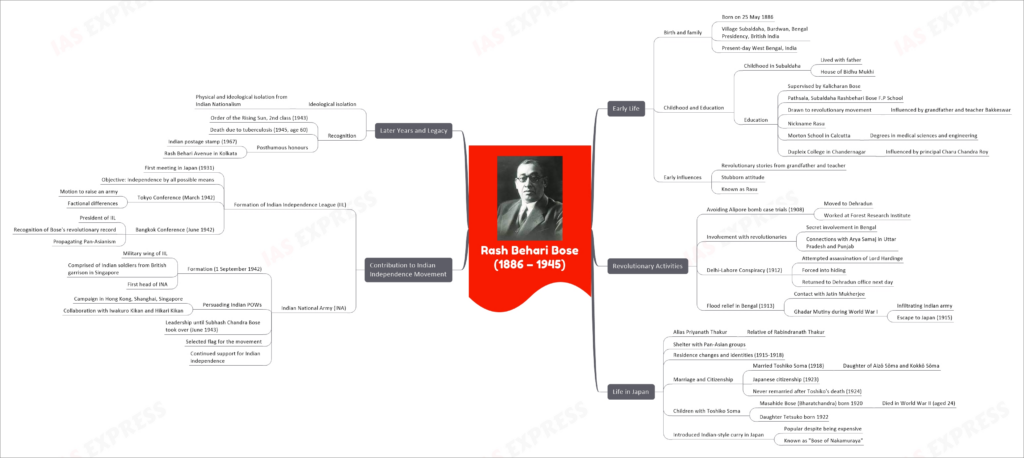Rash Behari Bose (1886 – 1945): A Revolutionary Journey
Rash Behari Bose, a prominent figure in the Indian independence movement, left an indelible mark on history through his revolutionary activities and contributions. Born on May 25, 1886, in Subaldaha, British India, his life unfolded in a manner that would eventually lead him to play a pivotal role in the fight for India’s independence.
Early Life:
- Birth and Family:
- Born on May 25, 1886, in Subaldaha, Burdwan, Bengal Presidency (Present-day West Bengal, India).
- Hailed from a humble family in British India.
- Childhood and Education:
- Spent his early years in Subaldaha, living with his father in the House of Bidhu Mukhi.
- His education was supervised by Kalicharan Bose.
- Attended Pathsala, Subaldaha Rashbehari Bose F.P School.
- Rash Behari Bose was drawn to the revolutionary movement, inspired by stories from his grandfather and teacher Bakkeswar.
- He was affectionately known as “Rasu.”
- Pursued degrees in medical sciences and engineering at Morton School in Calcutta.
- Later, he studied at Dupleix College in Chandernagar, where he was influenced by Principal Charu Chandra Roy.
- Early Influences:
- Revolutionary stories from his grandfather and teacher kindled his spirit.
- Rash Behari Bose was known for his stubborn attitude even from a young age.
Revolutionary Activities:
- Avoiding Alipore Bomb Case Trials (1908):
- To escape the Alipore bomb case trials, he moved to Dehradun.
- Worked at the Forest Research Institute, maintaining a low profile.
- Involvement with Revolutionaries:
- Maintained secret connections with revolutionaries in Bengal.
- Established connections with Arya Samaj in Uttar Pradesh and Punjab.
- Delhi-Lahore Conspiracy (1912):
- Participated in the attempted assassination of Lord Hardinge.
- Forced into hiding after the conspiracy.
- Remarkably, he returned to his office in Dehradun the very next day.
- Flood Relief in Bengal (1913):
- During flood relief efforts, he came in contact with Jatin Mukherjee.
- Later, Rash Behari Bose played a significant role in the Ghadar Mutiny during World War I, infiltrating the Indian army and ultimately escaping to Japan in 1915.
Life in Japan:
- Alias Priyanath Thakur:
- Adopted the alias “Priyanath Thakur” to maintain a covert identity.
- Interestingly, he was a relative of Rabindranath Thakur (Tagore).
- Shelter with Pan-Asian Groups:
- Found refuge and support among Pan-Asian groups in Japan.
- Marriage and Citizenship:
- Married Toshiko Soma in 1918, who was the daughter of Aizō Sōma and Kokkō Sōma.
- Attained Japanese citizenship in 1923.
- Rash Behari Bose never remarried after Toshiko’s unfortunate death in 1924.
- Children with Toshiko Soma:
- They had two children: Masahide Bose (Bharatchandra), born in 1920, who tragically died in World War II at the age of 24, and a daughter named Tetsuko, born in 1922.
- Introduced Indian-Style Curry in Japan:
- Pioneered the introduction of Indian-style curry in Japan, which gained popularity despite its relatively high cost.
- Fondly known as the “Bose of Nakamuraya.”
Contribution to the Indian Independence Movement:
- Formation of Indian Independence League (IIL):
- The IIL was formed in Japan in 1931, with the objective of achieving Indian independence by all possible means.
- Notable events include the Tokyo Conference in March 1942, where a motion to raise an army was discussed, and the Bangkok Conference in June 1942, where Rash Behari Bose became the President of IIL, further propagating Pan-Asianism.
- Indian National Army (INA):
- The INA was established on September 1, 1942, as the military wing of IIL.
- It comprised Indian soldiers from the British garrison in Singapore.
- Rash Behari Bose served as the first head of INA.
- He played a pivotal role in persuading Indian POWs to join the INA’s ranks, with campaigns in Hong Kong, Shanghai, and Singapore.
- Collaboration with Iwakuro Kikan and Hikari Kikan was instrumental in advancing the cause.
- Rash Behari Bose selected the flag for the movement and continued to lend his support to the fight for Indian independence.
Later Years and Legacy:
- Ideological Isolation:
- He experienced physical and ideological isolation from mainstream Indian nationalism during his later years.
- Recognition:
- In 1943, Rash Behari Bose was awarded the Order of the Rising Sun, 2nd class, in Japan.
- He passed away due to tuberculosis in 1945 at the age of 60.
- Posthumous honors include an Indian postage stamp issued in his memory in 1967 and the naming of Rash Behari Avenue in Kolkata.
Rash Behari Bose’s life was a testament to his unwavering commitment to the cause of Indian independence. From his early revolutionary influences to his instrumental role in the Indian National Army, his legacy endures as a symbol of resilience and dedication in the fight for freedom.


